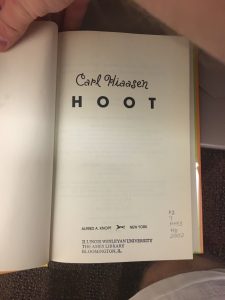Author(s) Illustrator/Photographer: Carl Hiaasen
Publisher and Year Number of pages: Alfred A. Knopf, 2002, 292 pages.
Genre: Realistic Fiction

Descriptive Annotation: The cover features a simple artistic rendering of a burrowing owl’s white eyes on a sky-blue background, very similar to other minimalist books of Carl Hiaasen’s that feature similar cover artwork. As for the book itself, it involves the engrossing story of Roy Eberhardt, a boy who is used to being a new kid. Florida isn’t the first state he’s lived in, but probably the most interesting place he’s ever been. We first meet Roy with his face being pressed against the window of his school bus by Dana Matheson, the local bully. While dealing with Dana, Roy meets a boy named Mullet Fingers and learns of a sinister plot involving a pancake house called Mother Paula’s, which is planned to be built on the site of an owl rookery. Roy used to hate Florida and mope about going back to Montana, but now he doesn’t think it’s so boring after all. Roy and Beatrice, his crush at school, have to decide whether or not to help protest for owls’ rights with Mullet Fingers by sabotaging the Mother Paula’s site, which is not an easy choice to make since he is already in trouble at school for ditching class to chase Mullet Fingers. Luckily for the reader, there isn’t much background knowledge needed to enjoy this story-all they need do is get comfortable in their favorite spot and get to enjoying it. The language is pretty simple but also profound in its own way and could be used for a variety of grade levels due to a mass appeal for readers with many different tastes.
Classroom Application: Since the book makes the protection of the environment at all costs from those who would besmirch or defile it an enormous priority, it’s an ideal text to teach lessons on sustainability and good stewardship of the Earth. The author subtly demonstrates that outright militancy and sabotage towards polluters isn’t the best avenue to pursue, and how the children best learn this lesson would be up to the teacher. The passion shown by the main characters in pursuing their goal of environmental preservation is certainly a trait for teaching purposes. One possible lesson after reading the book would be to review current events and find a story that gets the class excited about environmentalism. Students would also do well to recognize, as Roy does, that “Just because something is legal doesn’t automatically make it right” (Hiaasen, p. 180), and think about laws that exist in this country that may not necessarily have been just or good for every American, and how to go about changing them.
Linguistic and Cultural Diversity Analysis: Since the book is set in South Florida, the unique cultural blend formed in that region over the centuries is described to a large extent and would be great for a social studies-type course. The traditions of the Seminole peoples that originally settled the area thousands of years ago are ever-present. Hiaasen explains them to the reader through the character of Mullet Fingers, who is a barefoot young man that ran away from a “special” (read: Indian re-Education) school in Mobile, AL to come and protect the swamp that holds the owls from bulldozers that are coming to build a pancake house on their homes. The Seminole Nation has always been committed to maintaining and supporting the bounties and remaining in sync with those bounties, hence the fierce devotion Mullet Fingers has to the cause: “‘You bury those birds,’ Mullet Fingers said, ‘you gotta bury me, too.” (pg. 267). His zeal convinces Roy to stand up to the corporations as well, and the unity of both boys from drastically different backgrounds is a message that can resonate with many students if taught correctly. Goodness in oneself and others is also a key component in the book, as can be seen in Roy’s conversations with another character on Mullet Fingers: “‘Eberhardt, why do you care about this kid?’ It was a good question, and Roy wasn’t certain he could put the answer into words. there was something about the look on the boy’s face . . . something urgent and determined and unforgettable” (Hiaasen, pp. 74-75). That kind of lesson never gets old, no matter what sort of class you are teaching.

